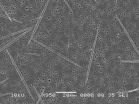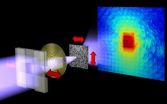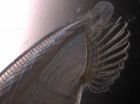(Press-News.org) HERSHEY, Pa. --A compound that stimulates the production of a tumor-fighting protein may improve the usefulness of the protein in cancer therapy, according to a team of researchers.
TRAIL is a natural anti-tumor protein that suppresses tumor development during immune surveillance -- the immune system's process of patrolling the body for cancer cells. This process is lost during cancer progression, which leads to uncontrolled growth and spread of tumors.
The ability of TRAIL to initiate cell death selectively in cancer cells has led to ongoing clinical trials with artificially created TRAIL or antibody proteins that mimic its action. Use of the TRAIL protein as a drug has shown that it is safe, but there have been some issues, including stability of the protein, cost of the drug, and the ability of the drug to distribute throughout the body and get into tumors, especially in the brain.
"The TRAIL pathway is a powerful way to suppress tumors but current approaches have limitations that we have been trying to overcome to unleash an effective and selective cancer therapy," said Dr. Wafik El-Deiry, professor of medicine and chief of the hematology/oncology division, Penn State College of Medicine. "The TRAIL biochemical cell death pathway naturally lends itself as a drug target to restore anti-tumor immunity."
Researchers have identified a compound called TRAIL-inducing Compound 10 (TIC10) as a potential solution. TIC10 stimulates the tumor suppression capabilities of TRAIL in both normal and tumor tissues, including in the brain, and induces tumor cell death in mice. They report their findings in the journal Science Translational Medicine.
TIC10 is a small molecule. This organic compound binds to a protein and alters what the protein does.
Stimulation of TRAIL protein is sustained in both tumor and normal cells, with the normal cells contributing to the TIC10-induced cancer cell death through a bystander effect. It is effective in cancer cell samples and cell lines resistant to conventional therapies.
"I was surprised and impressed that we were able to do this," El-Deiry said. "Using a small molecule to significantly boost and overcome limitations of the TRAIL pathway appears to be a promising way to address difficult to treat cancers using a safe mechanism already used in those with a normal effective immune system. This candidate new drug, a first-in-its-class, shows activity against a broad range of tumor types in mice and appears safe at this stage."
New treatments are needed for advanced cancer, as more than half a million people in the United States will die of cancer in 2013.
"We have enough preclinical information to support the rationale for testing this new drug in the clinic," El-Deiry said.
TIC10 seems to be nontoxic to normal cells or mice even at doses 10 times higher that an observed therapeutic dose. However, more research needs to be completed to satisfy FDA requirements prior to initiation of clinical testing.
INFORMATION:
Other researchers are Joshua E. Allen, David T. Dicker, Akshal S. Patel, Nathan G. Dolloff, Kimberly A. Scata,Wenge Wang, all of Penn State Hershey Cancer Institute; Gabriel Krigsfeld, Patrick A. Mayes, Luv Patel, University of Pennsylvania School of Medicine; Evangelos Messaris, Department of Surgery, Penn State College Medicine; Jun-Ying Zhou and Gen Sheng Wu, Wayne State University School of Medicine.
This study was funded by the American Cancer Society, Penn State Hershey Cancer Institute and the National Institutes of Health.
END
Bad news about the economy could cause you to pack on the pounds. This according to a new study from the University of Miami School of Business Administration published in the February edition of Psychological Science, a journal of the Association of Psychological Science. The study shows that when there is a perception of tough times, people tend to seek higher-calorie foods that will keep them satisfied longer. When subconsciously primed with such messages, a "live for today" impulse is triggered causing people to consume nearly 40 percent more food than when compared ...
With help from a wind tunnel and the latest DNA technology, U.S. Department of Agriculture (USDA) scientists are shedding light on the travel patterns of microbes in soils carried off by strong winds. The work has implications for soil health and could lead to management practices that minimize the damage to soils caused by wind erosion.
Wind erosion is an emerging issue in soil conservation efforts. Agricultural Research Service (ARS) scientists have been studying wind-eroded soils since the 1930s, but few studies have focused on the effects of wind on the bacteria, ...
INDIANAPOLIS -- Medical literature long has touted the benefits of omega-3 fatty acids for the heart. But until now, researchers have not studied the potential benefit for people on hemodialysis, who are among the highest-risk patients for sudden cardiac death.
A study published Feb. 6 online in the journal Kidney International, which included 100 patients who died of sudden cardiac death during their first year of hemodialysis and 300 patients who survived, is the first to examine this question.
Allon N. Friedman, M.D., associate professor of medicine in the Division ...
SAN FRANCISCO, Feb. 6, 2013 -- Nitrogen in ocean waters fuels the growth of two tiny but toxic phytoplankton species that are harmful to marine life and human health, warns a new study published in the Journal of Phycology.
Researchers from San Francisco State University found that nitrogen entering the ocean -- whether through natural processes or pollution -- boosts the growth and toxicity of a group of phytoplankton that can cause the human illness Amnesic Shellfish Poisoning.
Commonly found in marine waters off the North American West Coast, these diatoms (phytoplankton ...
Since the observations made by English naturalist Charles Darwin on the Galapagos Islands, researchers have been interested in how physical barriers, such as isolation on a particular island, can lead to the formation of new species through the process of natural selection. Natural selection is a process whereby heritable traits that enhance survival become more common in successive generations, while unfavorable heritable traits become less common. Over time, animals and plants that have morphologies or other attributes that enhance their suitability to a particular environment ...
ANN ARBOR—Hunger, thirst, stress and drugs can create a change in the brain that transforms a repulsive feeling into a strong positive "wanting," a new University of Michigan study indicates.
The research used salt appetite to show how powerful natural mechanisms of brain desires can instantly transform a cue that always predicted a repulsive Dead Sea Salt solution into an eagerly wanted beacon or motivational magnet.
Mike Robinson, a research fellow in the U-M Department of Psychology and the study's lead author, said the findings help explain how related brain activations ...
AUDIO:
In the 1970s and early 1980s, some states lower their minimum legal drinking age below the age of 21. Those lower drinking ages have been linked to bad things, from...
Click here for more information.
People who grew up in states where it was legal to drink alcohol before age 21 are more likely to be binge drinkers later in life, according to a study by researchers at Washington University School of Medicine in St. Louis.
The findings are available online in Alcoholism: ...
For more than 100 years radiography meant: don't move! In order to visualize nanostructures such as biological cells, the porous structure of cement or storage fields of magnetic disks, the experimentators had to avoid any kind of vibration of X-ray microscope and sample. In addition, only a small percentage fraction of the incoming X-ray radiation could be used. Using special filters, they had to select exactly the fraction with the right properties – for example, the right wavelength.
Contributions of different wavelengths separated
Pierre Thibault of the Technische ...
CHICAGO -- Feeding human breast milk to very-low-birth-weight infants greatly reduces risk for sepsis and significantly lowers associated neonatal intensive care unit (NICU) costs, according to a study by Rush University Medical Center researchers.
The study, published Jan. 31 in the advance online version of the Journal of Perinatology, showed that every 10 milliliters of human milk per kilogram that a very low birth weight infant received during the first 28 days of life decreased the odds of sepsis by almost 20 percent.
A daily dose of 25 to 49.99 milliliters of ...
WOODS HOLE, MASS. -- Among the animals that are appealing "cover models" for scientific journals, lancelets don't spring readily to mind. Slender, limbless, primitive blobs that look pretty much the same end to end, lancelets "are extremely boring. I wouldn't recommend them for a home aquarium," says Enrico Nasi, adjunct senior scientist at the Marine Biological Laboratory (MBL). Yet Nasi and his collaborators managed to land a lancelet on the cover of the Journal of Neuroscience last December. These simple chordates, they discovered, offer insight into our own biological ...



